Gilead does not exist. At least it didn’t until The Handmaid’s Tale production team created it from scratch.
Because Margaret Atwood’s alarmingly prescient novel is set in a dystopic version of what America could become, it had to feel real. Every wordless sign, every ominous nook and cranny, every wing-wearing handmaid had to reinforce the novel’s vision and makes viewers believe Gilead actually does exist. (Also doing that job at this moment: reality.) The task of rendering this world recognizable as our own largely rested on the shoulders of the production designers.
This crew, which was overseen in season two by Mark White and Elisabeth Williams, coordinated with series creator Bruce Miller and a multitude of creative entities to make hundreds of large and small decisions on how the physical space, props, color palette, and lighting all should look.
“We probably went through at least 30 reds to decide on the shade of the handmaids’ robes,” says executive producer Warren Littlefield, a TV veteran who has worked on everything from Cheers to The West Wing.
Some details come straight from the book, while others are created from whole cloth based on the production designer’s interpretation. In either instance, Miller makes it a point to give the team leeway to follow their vision.
“The iris of an eye is a recurring visual theme throughout the season,” Elisabeth Williams says. “It’s in the courtyard when the women are standing in the circles holding stones, there’s a scene in the graveyard where all the coffins are placed in a circle. We tried to make that iris appear as often as people, so that it’s always watching. That’s something that came out of a production design conversation.”
Because the second season moves beyond the action of Atwood’s novel, the team faced a whole new set of challenges. With season one, the cast and crew were trying to honor Atwood’s vision; with season two, they were honoring everything at stake in the post-truth world. Fast Company spoke with Littlefield and Williams about some of the more memorable settings of the new season’s first few episodes.
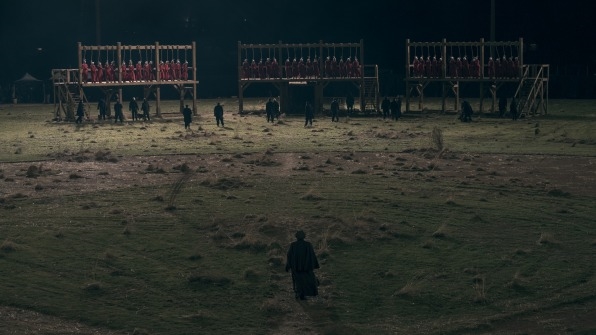
Fenway Park
Bruce Miller set the scene of episode one’s mass mock-execution in Fenway Park, even though he wasn’t sure whether it would work out logistically. He chose the storied Boston baseball field because he looked at fascist regimes throughout the world and knew that they use public spaces such as soccer stadiums for sites of torture and execution.
“As much as what happens there is a statement, where it happens is a statement, too,” Littlefield says.
The question of whether the location would be usable ultimately hinged on Littlefield’s relationship with Tom Werner, the chairman of the Boston Red Sox. The producer ended up engaging with Werner and representatives from Major League Baseball and Fenway Park to try and convince them to let the show use the beloved Boston landmark.
“Eventually, they asked me, ‘Why is this good for baseball?’” Littlefield recalls. “I told them, ‘I think when you go into this scene you will feel the tragedy of what was lost and the history of the sport in this hallowed ground that is no longer.’ They embraced it.”
The visual effects unit shot in the stadium one night, while the actors were filmed at Bernie Arbour Stadium in Hamilton, Ontario, which was made to look abandoned and divot-pocked, as though baseball had been gone for years. Using digital wizardry, the two settings were seamlessly integrated together.
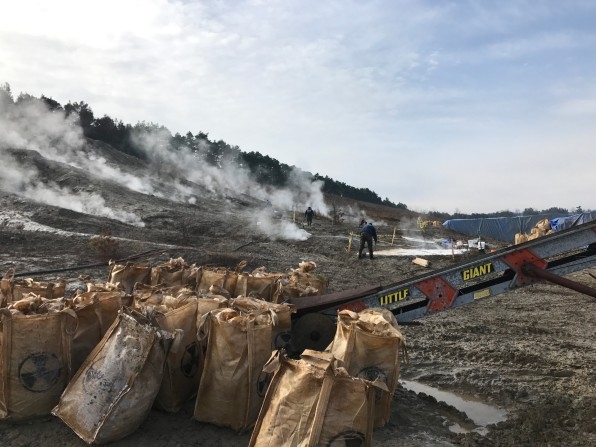
The Colonies
One of the most chilling aspects of the novel is the place known as the Colonies. It’s a toxic wasteland where women are condemned to work themselves to death. As much as the concept of the Colonies stands out in the novel, it is barely described at all, leaving the heavy lifting to the reader’s imagination. The production design team had to deliver something that generations of readers had already pictured in their minds’ eye.
“We researched gulags, of course, along with different penal farms, different slavery environments in many different countries that have it in their history,” Williams says. “Also, we researched environmental disasters. The one we were inspired by for our dirt mounds was the Fukushima disaster, where thousands of acres of soil were contaminated and taken out of the earth, so we took those references and used them to conceive of the colonies. At the same time, it was important and scripted by Bruce and the other writers that this would all be a bucolic and beautiful environment, and so our inspiration for that was Dutch paintings. There are blues and yellows and grays, just very beautiful, and the contrast between the beauty of nature and the horrors that are going on there is most compelling for those images.”
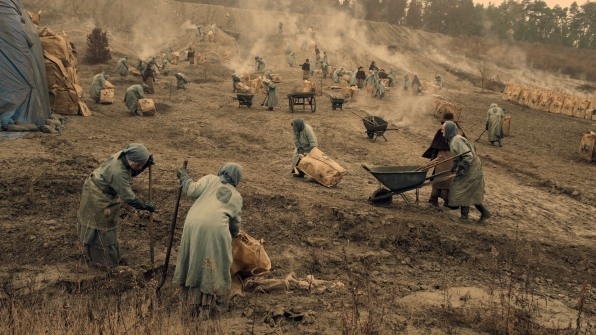
In order to create the Colonies convincingly, the team needed wide open spaces that go on and on. They ended up filming on a stretch of land in Uxbridge, about 50 miles outside of Toronto. Although they ended up creating an entire road and some geodesic domes to emphasize the scope of the place, some aspects of the scenery were already there, including a barn that is over 100 years old–which the team gutted and customized.
“In the world of the show, the farm is repurposing an existing building, so there’s nothing constructed with that, it is what it is. Resources are wasted on these women–or Unwomen, as we call them—so everything looks recycled,” Williams says. “The beds are recycled from the army. The blankets are from the army. They make their food themselves from a garden just outside for sustenance, there’s just enough to survive, but nothing more. And they bury their own dead.”
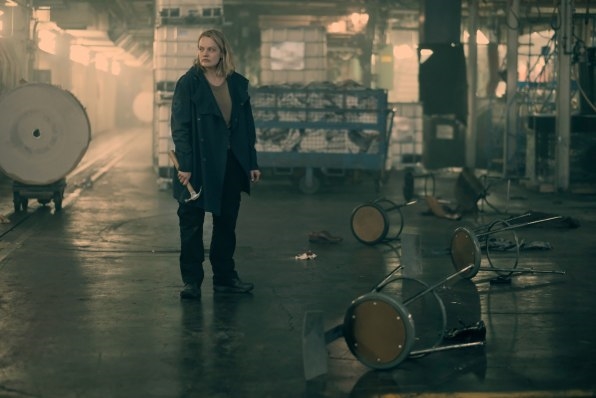
Boston Globe Headquarters
In the second episode of the new season, Offred/June (Elisabeth Moss) is temporarily smuggled to a makeshift safe house for hiding until she can potentially escape to Toronto. As she slinks around the empty shell of a building, it becomes clear she’s inside the Boston Globe headquarters.
“Knowing that Gilead has attacked free press and the Globe has this wonderful history of celebrating freedom, Bruce thought it was a powerful message of indicating what the far right, what this regime of Gilead, had done to the freedom of the press,” Littlefield recalls. “And it reveals the tragedy of being the free press in this world, and what that meant for so many lives there.”
As June strolls around to an area modeled after the Globe‘s press room, she discovers how many of those lives ended. She finds an execution wall riddled with bullet holes and streaked with blood, which she converts into a memorial.
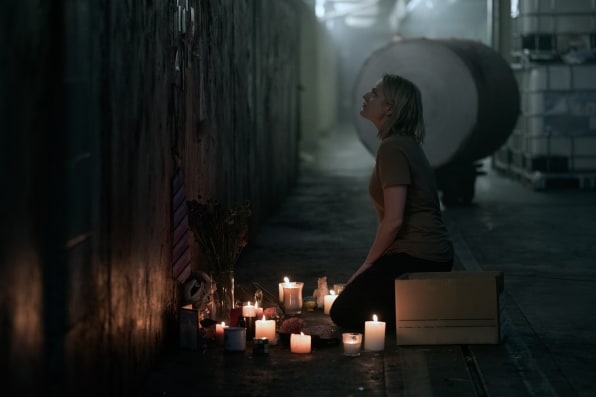
Using the same connections he had at Fenway, Littlefield asked permission from management at the Globe, who fully cooperated. The production design team then took references specifically from the Globe of what offices and printing presses look like, and converted the Hamilton Herald in Toronto accordingly for filming.
It was a scene that had a lot of emotional resonance for the show’s creators, considering the current political climate.
“All we have to do is look at the past couple of days, or any day, to know how much, under the Trump administration, the press is under attack,” Littlefield says. “The president didn’t attend the White House Correspondents’ Dinner, which celebrates the First Amendment, so it’s pretty clear. [This scene] just felt like a good choice for how to continue the story.”
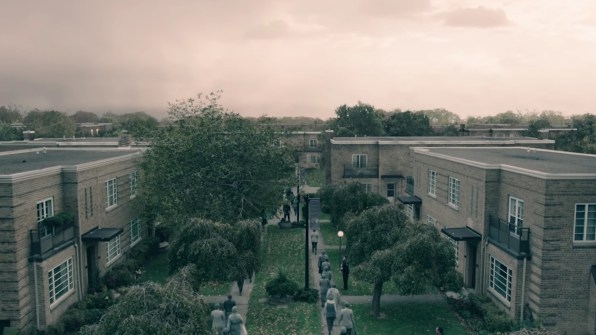
Econo Village
The Econo Village, the spookily clean and orderly place where June briefly hides after leaving the Globe, is based on regimented housing complexes which level out, or at least mask, differences in society. It was approximated in a group of buildings in Toronto.
“The minimalist interiors were inspired by our research on Mennonites and the simplicity of functionality of communities whose lifestyle is not one of indulgence, but one of hard work and pious thoughts,” Williams says. “The apartment is dressed with wooden furniture and toys, handmade objects and linens, herbs from the vegetable gardens created in the courtyard for self sustenance, homemade bread and preserves, painting of idyllic scenery and propaganda.”
Fast Company , Read Full Story
(65)